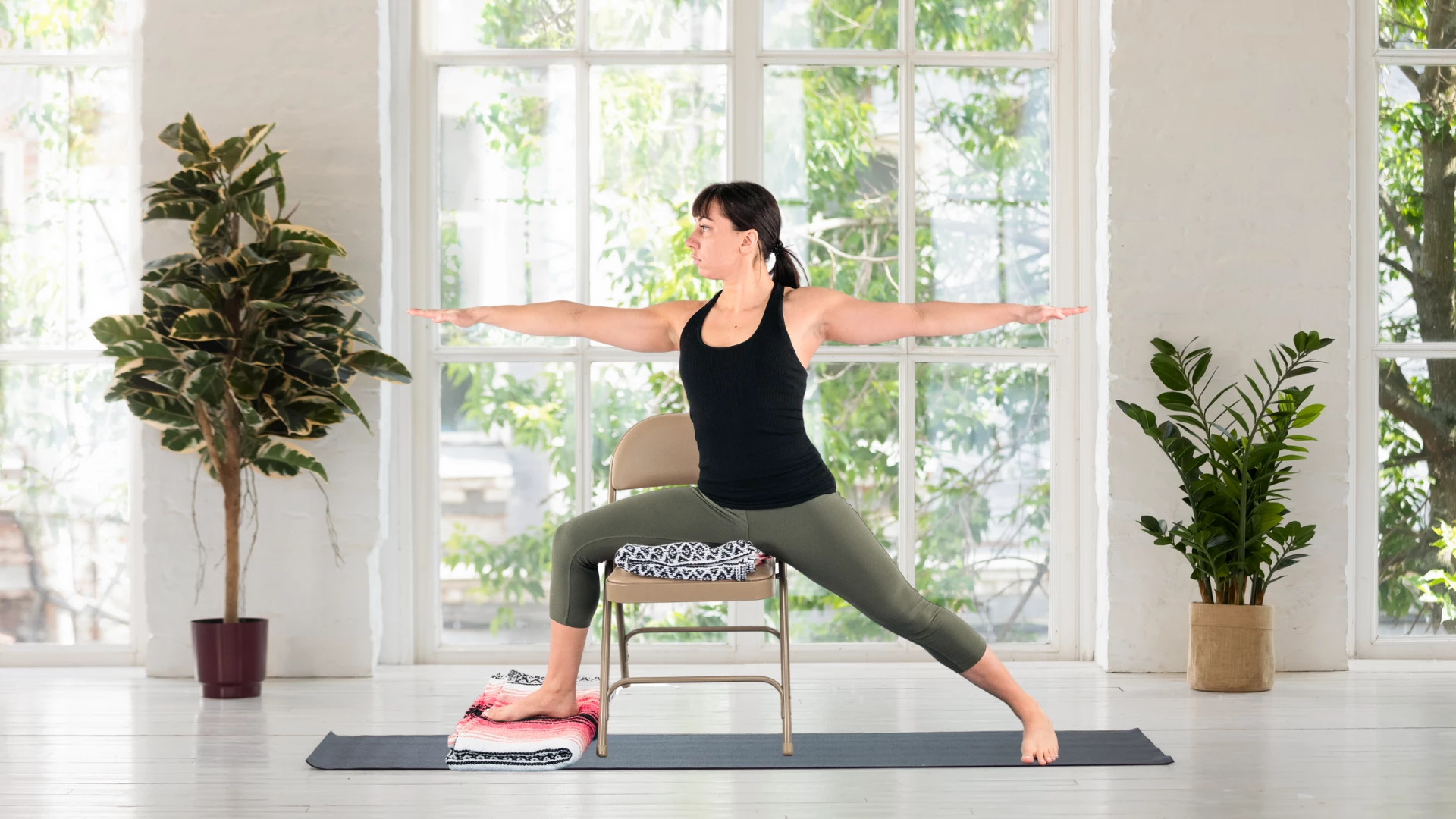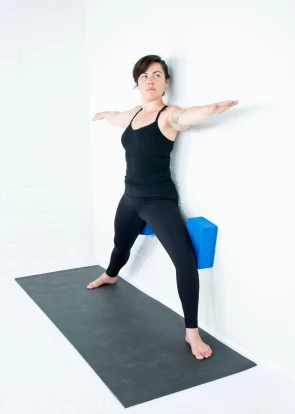Why We Need to Redefine Yoga Alignment in Asana

Article At A Glance
Are yoga cues always helpful? Often yoga alignment cues can perpetuate unrealistic goals. This article explores why cues may not be benefiting you and how to listen to your body and focus on the true purpose of the pose.
Yoga alignment cues very often seem to perpetuate throughout the yoga world, passed down from one teacher to another. Some are very useful and informative. Others may need to be reconsidered.
So often, yoga teachers offer “universal alignment cues.” They teach steadfast rules to each and every one of their students, regardless of their varying body types, strengths, and weaknesses.
In my personal experience, I think that “healthy knee alignment” cues have been perpetuated more than many others.
We’ve all heard the same repetitive cues from our yoga teachers:
- Align your knee directly over your ankle.
- Bend your knee to a 90-degree angle.
- Traction your knee toward your pinky toe.
- Point your toes and your knee in the same direction.
While I don’t think that these are necessarily “bad” cues, I do think that they are not universal and cannot and do not apply to every yoga practitioner—or even necessarily the majority of yoga practitioners.
Why We Need to Redefine “Proper Yoga Alignment” in Poses
Yoga alignment is often taught under the guise of safety. As students, we’re led to believe that if we angle our toes in a different direction than our teacher instructed, we run the risk of severely damaging our knee joint. Or if we angle our knee inwards in Warrior II contrary to our teacher’s cues, then we might tear our menisci (thin fibrous cartilage within the knee joint).
While this may be true for some students, it isn’t necessarily true for all students or even most students. So why are we instructing these cues as if they were the gospel truth?
Alignment needs to be deeply individualized and should be instructed as such. When we offer cues as “safety parameters” and imply that they apply to all students, we may risk injuring our students even more so than if we allowed them to listen to their body’s innate wisdom.
We Have to Consider Morphology When Cueing Yoga Alignment
If we look at this topic from a morphological perspective, we can see how inherently different we are straight down to our bones.
Bones in our bodies grow in a spiral pattern. This is called torsion. Also, nothing in our bodies is truly symmetrical. Sometimes there is more symmetry, and sometimes there is less.
When we consider standing postures like Warrior II, we have to consider this torsion and asymmetry when we offer our cues.
A posture like Warrior II requires a lot of different joints and parts to come together to create the shape. There is a lot of muscular energy and a lot of flexibility required to align the pose. And there are a lot of bones that must align in different ways to create the shape.
Because there are so many different bones involved, the shape and curvature of the bones could affect the way the posture may look from an aesthetic standpoint.
For example, a student may have a small amount of torsion in one direction in their femur (thigh bone) and a great amount of torsion in another direction in their tibia (shin bone). This may cause their thigh bone to angle inward and their foot to angle outward in Warrior II. This does not necessarily mean that they risk injury to their ankle or knee; it simply is how their bones are shaped and how this manifests in Warrior II.
Although their posture may not look like the “traditional” yoga alignment of Warrior II, it in no way indicates that how they practice the posture is dangerous or wrong. In fact, for their particular body type, this may very well be the safest and most stable way for them to practice Warrior II.
We Also Have to Consider Soft Tissue Restrictions When Cueing Yoga Alignment
 Also, of course, we have to consider the strengths and weaknesses in our students’ bodies in terms of the strength and flexibility in their muscles and connective tissues as well.
Also, of course, we have to consider the strengths and weaknesses in our students’ bodies in terms of the strength and flexibility in their muscles and connective tissues as well.
This knee and ankle alignment in Warrior II could be due to their actual bone structure. But it could also be due to restrictions in their soft tissues as well.
This same student could potentially have really tight adductors (inner thigh muscles) so drawing the knee toward the pinky toe (AKA abduction) may simply be impossible for them due to the restriction they experience in their soft tissue. If you force this student to traction their knee toward their pinky toe, they must compensate in another place in their body because they don’t have the flexibility in their adductors for this action.
So, they may be forced to alter their shape in a different joint or a different body part to compensate for their tight adductors. This, in and of itself, isn’t necessarily a bad thing. But it has the potential to cause just as much or even more harm to them as would simply allowing their body to move to its end range of motion in the adductors in the quote “misaligned” Warrior II.
We Never Know What’s Happening Internally From an External View of a Yoga Posture
As teachers, when we look at our students from the outside and see an aesthetic posture, we really have no idea what is happening internally to create that shape. While from an outsider’s perspective, we may see two students who are “perfectly aligned” in a classic Warrior II, they are definitely feeling it very differently internally.
One student may be working their internal rotators excessively to bring their knee and foot to point straight forward. The other may be working their external rotators excessively to bring their knee and foot to point straight forward. Those are the exact opposite muscle groups on the exact opposite side of the joint.
While working different muscle groups isn’t inherently bad, if we continuously require our students to follow these strict “universal” yoga alignment cues repetitively, they may run the risk of damaging their tissues in the long run.

When It Comes to Yoga Alignment, Let the Purpose of the Pose Guide Your Practice
Instead of striving for aesthetic alignments in our practice and our teachings, it likely would be much wiser to strive for internal sensations as we create postures and shapes.
What is it that we are trying to achieve by practicing Warrior II? Are we striving to stretch the adductors? Are we attempting to strengthen the external rotators of the hips? Are we working to strengthen the quadriceps of the thigh? Are we trying to lengthen the hip flexor of the back leg?
If we consider these questions, we can better offer cues to our students about how to effectively do these actions rather than how to make a pose simply look a certain way without regard to how it is affecting them internally.
So, it may be wise to redefine our understanding of classical yoga alignment cues and to finally come to the understanding that alignment is not universal and that it really never can be. Because we are all inherently unique, our yoga practice and our yoga cues need to be just as unique as we are.
Also, read...
4 Ways to Practice Locust Pose
5 Keys to Healthy Neck Alignment in Cobra Pose (Bhujangasana)
Uttanasana: Expand Your Breath
Related courses
Breath as Medicine: Yogic Breathing for Vital Aging
Yoga and Myofascial Release: Releasing Chronic Tension with the Bodymind Ballwork Method

Leah Sugerman is a yoga teacher, writer, and passionate world traveler. An eternally grateful student, she has trained in countless schools and traditions of the practice. She teaches a fusion of the styles she has studied with a strong emphasis on breath, alignment, and anatomical integrity. Leah teaches workshops, retreats, and trainings, both internationally and online. For more information, visit www.leahsugerman.com.




